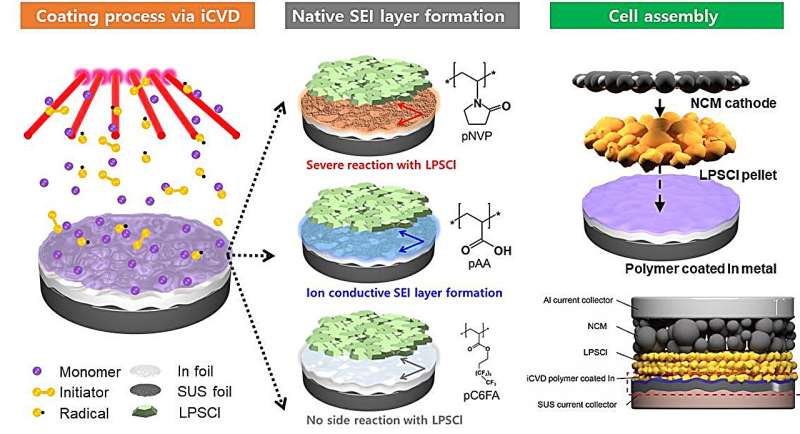Battery researchers unveil the interaction between polymeric materials and sulfide solid electrolytes
A recent study in the field of chemistry demonstrates that maintaining distance can enhance battery performance in electric vehicles. In this study, a research team successfully developed a polymeric protective film that enables safe operation of the anode in sulfide-based all-solid-state batteries. Their research was published in the online edition of Advanced Functional Materials.
The competitiveness of electric vehicles hinges on their range and charging speed, both of which are directly influenced by battery performance. This is why battery research is currently so intensive. Stability is also crucial, and the lithium (Li) ion batteries currently on the market, which use a liquid electrolyte and polymer separator, are susceptible to temperature variations and external impacts.
To address these issues, all-solid-state batteries with solid electrolytes, which can function as both a liquid electrolyte and a polymer separator, have recently been developed. Sulfide-based solid electrolytes have high ionic conductivity (2.5 x 10-2 S/cm), making the battery assembly process very simple. However, the interface between the electrode active material and the electrolyte is chemically and electrochemically unstable, leading to increased internal resistance and reduced battery performance.
To solve this issue, the team introduced polymeric materials to prevent direct contact between the anode and the electrolyte in batteries. Using the initiated chemical vapor deposition (iCVD) process, they created a uniform 100 nm (nanometer) thick anode coating film from eight different polymers with varying polarities.
The team assessed the interfacial stability and battery performance using these eight polymeric thin films for anode coating. The results demonstrate that thin films made of polymers containing -COOH and C-F bonds (pAA, pC6FA) significantly improved the interfacial stability between the all-solid-state battery anode and electrolyte.
All-solid-state batteries utilizing this approach exhibited a high-capacity retention rate (pAA: 64.8%, pC6FA: 50.7%) after more than 100 cycles, a notable improvement over the 29.0% capacity retention rate of conventional all-solid-state batteries without anode coating.
To date, there has been limited research on these polymeric materials in sulfide-based all-solid-state batteries, making this research significant as it reveals the interaction between the polymeric materials and the sulfide solid electrolyte.
The team includes Professor Soojin Park, Dr. Sungjin Cho and Youngjin Song, a Ph.D. student, from the Department of Chemistry at Pohang University of Science and Technology (POSTECH) in collaboration with the team of Professor Sung Gap Im from the Department of Chemical and Biomolecular Engineering at Korea Advanced Institute of Science and Technology (KAIST).
Professor Park stated, “We have demonstrated new potential in enhancing the long-term stability of sulfide-based all-solid-state batteries. This work represents a major turning point in the research of sulfide all-solid-state batteries, the next generation of battery technology.”
More information:
Sungjin Cho et al, Functional Polymer Thin Films for Establishing an Effective Electrode Interface in Sulfide‐Based Solid‐State Batteries, Advanced Functional Materials (2024). DOI: 10.1002/adfm.202314710
Pohang University of Science and Technology
Citation:
Battery researchers unveil the interaction between polymeric materials and sulfide solid electrolytes (2024, May 29)
retrieved 30 May 2024
from https://techxplore.com/news/2024-05-battery-unveil-interaction-polymeric-materials.html
This document is subject to copyright. Apart from any fair dealing for the purpose of private study or research, no
part may be reproduced without the written permission. The content is provided for information purposes only.

Comments are closed